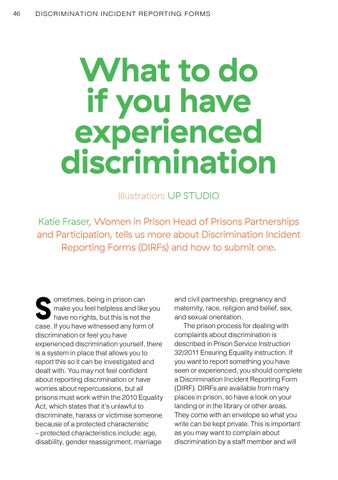46
DISCRIMINATION INCIDENT REPORTING FORMS
What to do if you have experienced discrimination Illustration: UP STUDIO Katie Fraser, Women in Prison Head of Prisons Partnerships and Participation, tells us more about Discrimination Incident Reporting Forms (DIRFs) and how to submit one.
S
ometimes, being in prison can make you feel helpless and like you have no rights, but this is not the case. If you have witnessed any form of discrimination or feel you have experienced discrimination yourself, there is a system in place that allows you to report this so it can be investigated and dealt with. ou may not feel confident about reporting discrimination or have worries about repercussions, but all prisons must work within the 2010 Equality Act, which states that it’s unlawful to discriminate, harass or victimise someone because of a protected characteristic – protected characteristics include: age, disability, gender reassignment, marriage
and civil partnership, pregnancy and maternity, race, religion and belief, sex, and sexual orientation. The prison process for dealing with complaints about discrimination is described in Prison Service Instruction 32/2011 Ensuring Equality instruction. If you want to report something you have seen or experienced, you should complete a Discrimination Incident Reporting Form (DIRF). DIRFs are available from many places in prison, so have a look on your landing or in the library or other areas. They come with an envelope so what you write can be kept private. This is important as you may want to complain about discrimination by a staff member and will















